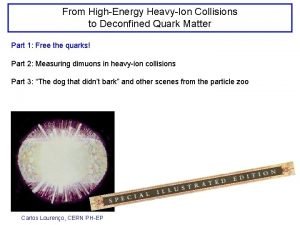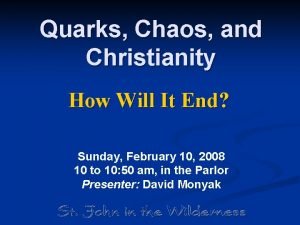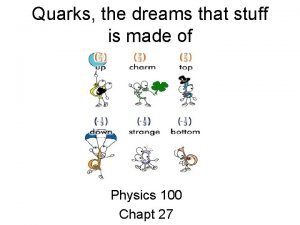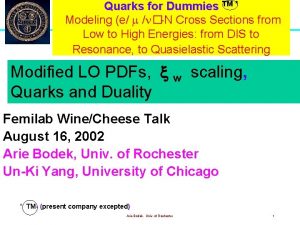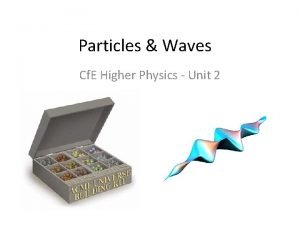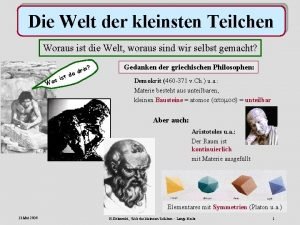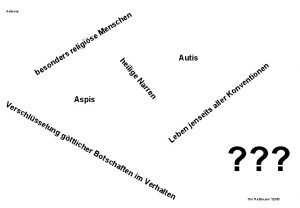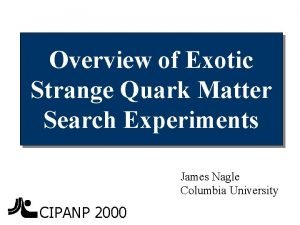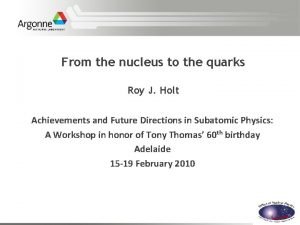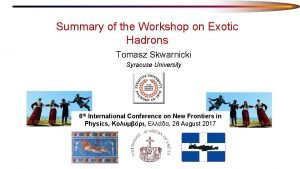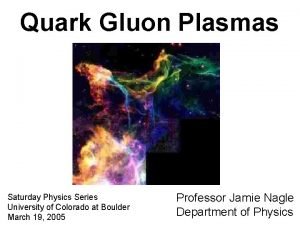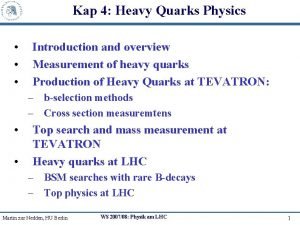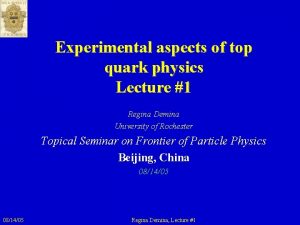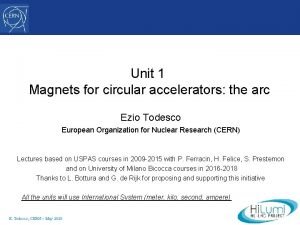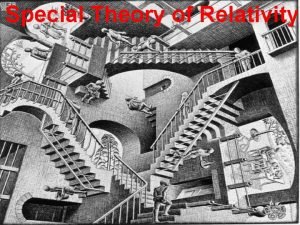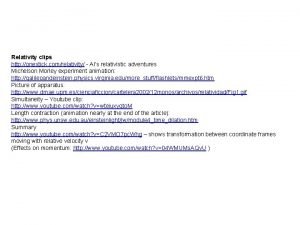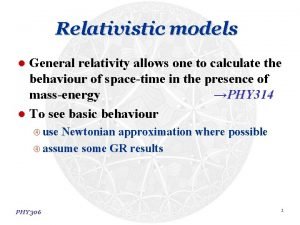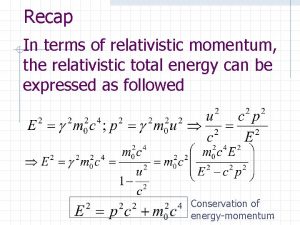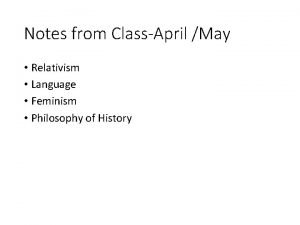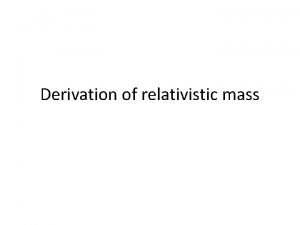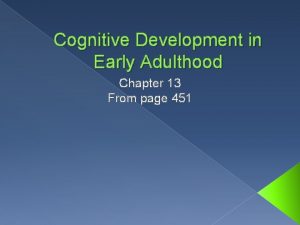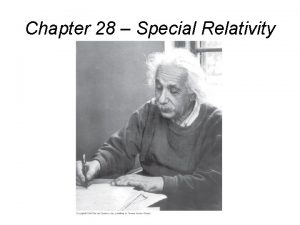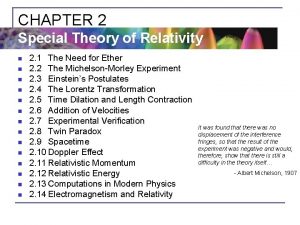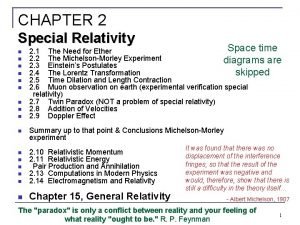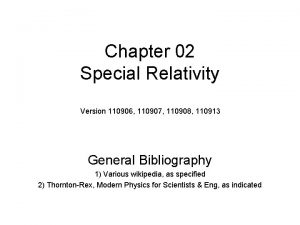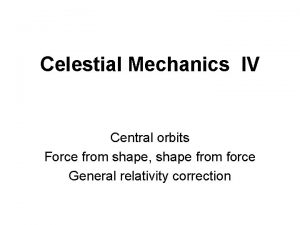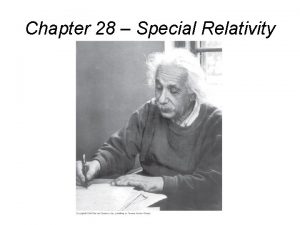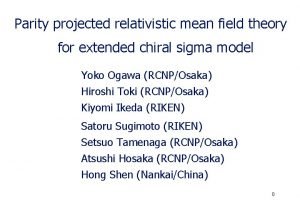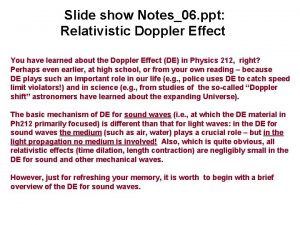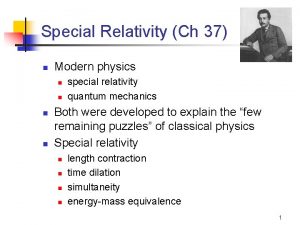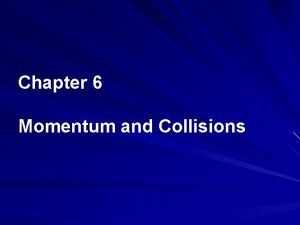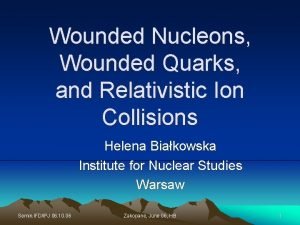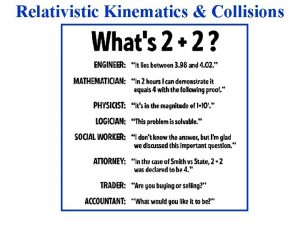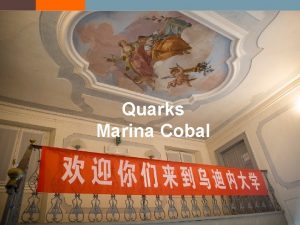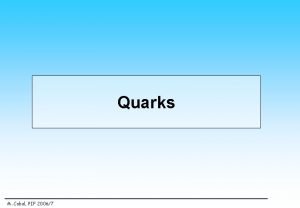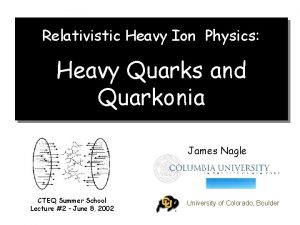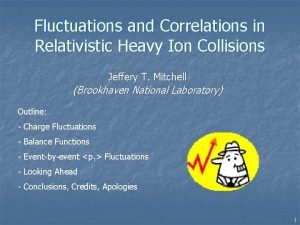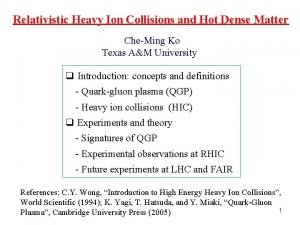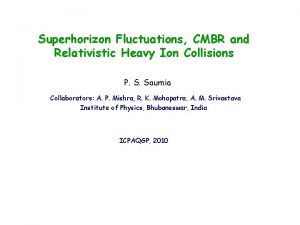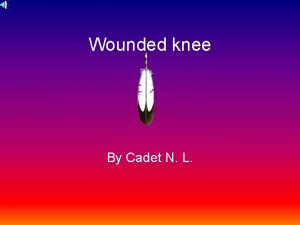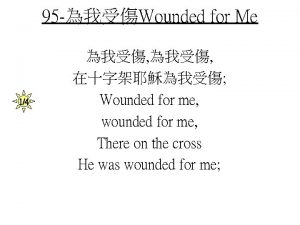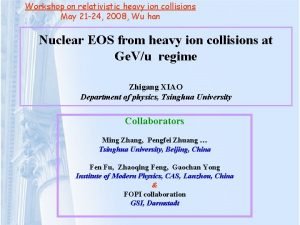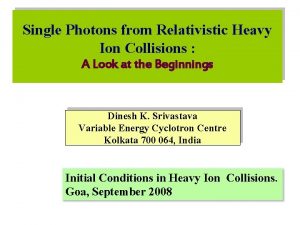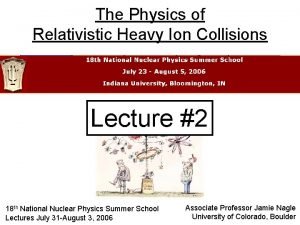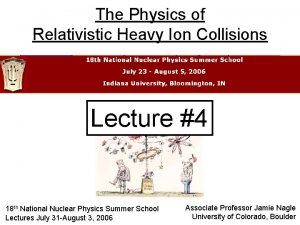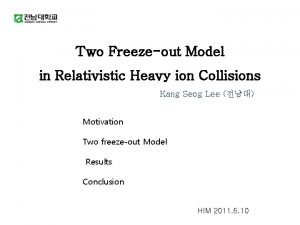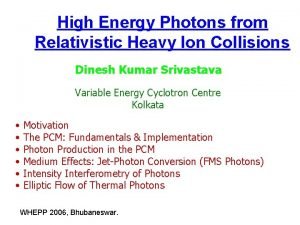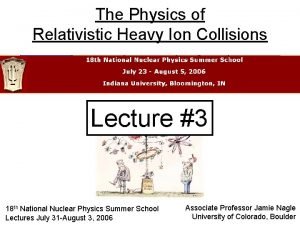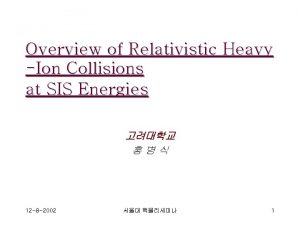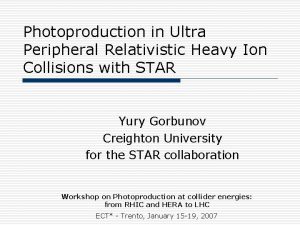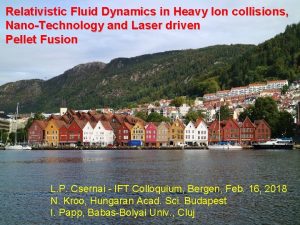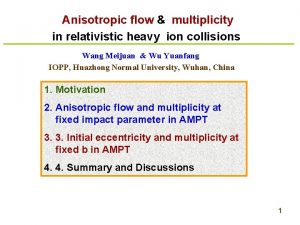Wounded Nucleons Wounded Quarks and Relativistic Ion Collisions







































- Slides: 39

Wounded Nucleons, Wounded Quarks, and Relativistic Ion Collisions Helena Białkowska Institute for Nuclear Studies Warsaw Zakopane, June 06, HB 1

What is a wounded nucleon? • Classic definition, given by Białas, Błeszyński & Czyż in 1976: It is a nucleon that underwent at least one inelastic collision Zakopane, June 06, HB 2

The WNM (1976!) – as usual – started from experimental observation: • Series of Fermilab expt`s on h-A • also European NA 5 • and lots of emulsion data • Average multiplicity and increases more slowly than the number of collisions Zakopane, June 06, HB 3

Observation: ratio of multiplicities (h. A/hp) behaves as And this is just the ratio of participants in p-A (1 from p and n from nucleus A) and in p-p (2 protons) Zakopane, June 06, HB 4

The Model: Particle production in a nuclear collision a superposition of independent contributions from the wounded nucleons in the projectile and the target Thus you can: 1 just measure NN 2 count the participants in h - A 3 and you have particle multiplicity in h – A! Zakopane, June 06, HB 5

Notice: we check here both Npart scaling and pp scaling For p-A: works surprisingly well. from AGS energies up to RHIC! Zakopane, June 06, HB 6

New idea: not wounded nucleons but wounded quarks Andrzej Białas et al. , 1977, Vladimir Anisovitch et al. , 1978 Zakopane, June 06, HB 7

Additive Quark Model 1982 Białas et al. : Specific predictions for nuclear collisions on the basis of the Additive Quark Model - with particle production from three sources: Breaking of the color strings between quarks from the projectile and the target Fragmentation of wounded quarks Fragmentation of spectator quarks Zakopane, June 06, HB 8

Pre-history: 1980 AQM Model: 3. 0 Model 1. 6 P, d, , C on Ta, 4. 2 Ge. V/N JINR DUBNA Zakopane, June 06, HB 9

More history: NA 35 First real high energy nuclear beams: 200 Ge. V/c O and S from SPS K. Kadija et al. , ZPhys. C 66, 393(1995) consistent parametrization of production rates of negatives – proportional to the No of wounded nucleons and of kaons – proportional to wounded quarks Zakopane, June 06, HB 10

WNAB works for negatives … and it does not for K 0 s Zakopane, June 06, HB 11

For kaons - need Wq Zakopane, June 06, HB 12

Now for RHIC A – A data: PHOBOS White Paper Notice: Au. Au scaled by pp at twice the energy! (to account for ‘leading baryon’) Zakopane, June 06, HB 13

Almost the same plot Here it looks better but… read the fine print! Au. Au normalized to e+e- Zakopane, June 06, HB 14

Look more closely at total multiplicity per Npart for Au - Au Proportionality, but higher than for pp at the same energy pp systematically lower WNM does not work Zakopane, June 06, HB 15

Still, the scaling with Npart is surprising and not only for total multiplicities : : 62. 4 Ge. V d. N/d PHOBOS 200 Ge. V Cu+Cu PHOBOS Preliminary Cu+Cu 3 -6%, Npart = 100 Preliminary 3 -6%, Npart = 96 Au+Au 35 -40%, Npart = 99 Au+Au 35 -40%, Npart = 98 Zakopane, June 06, HB 16

This ‘geometric’ scaling with Npart works PHOBOS Au+Au PRL 94, 082304(2005) not only for soft (low pt) data! PLB 578, 297(2004) Cu+Cu PRL(2006) accepted Cu+Cu (courtesy of Barbara Wosiek) preliminary Au+Au Zakopane, June 06, HB 17

A very specific come-back of WNM A. Białas & W. Czyż, first presented in Zakopane in 2004: a two-component WNM to describe d-Au at 200 Ge. V/c Basic assumption: Superposition of independent contributions from WN in the projectile and the target Applies not only to the total charged multiplicity but longitudinal spectra also Zakopane, June 06, HB 18

Density of particles in A – B collision: The model requires And the first consequence is (F is a contribution from a single wounded nucleon) Zakopane, June 06, HB 19

PHOBOS d. Au 200 Ge. V A. Białas, W. Czyż, Acta Phys. Pol. B 36, 905(2005) Zakopane, June 06, HB 20

For full (pseudo)rapidity range: construct symmetric and antisymmetric component And compare to data: Zakopane, June 06, HB 21

centrality Symmetric and antisymmetric part for several centralities d. Au: Zakopane, June 06, HB 22

Interpretation by the authors: The contribution from one wounded nucleon extends over full rapidity range There is a big difference between its symmetric and antisymmetric part Two step particle production: 1. Multiple color exchanges between partons from projectile and target 2. Particle emission from color sources created in step 1 (AB+Marek Jeżabek, Phys. Lett. B 590, 233 (2004)) Zakopane, June 06, HB 23

Revival of wounded quarks concept for A - A S. Eremin & S. Voloshin, Phys. Rev. C 67, 064905 (2003) Recall: at midrapidity – increase of d. N/d per participant with Npart As Zakopane, June 06, HB 24

Try Nq-part instead of NNpart To calculate: use same Nuclear Overlap Calculation (K. J. Eskola et al. , Nucl. Phys. B 323, 37(1989)) as for N-N, but change density and s Zakopane, June 06, HB 25

Calculating Nn-part and Nq-part Mass numbers of colliding nuclei are 3 times larger, but their size is the same. For pp the same procedure with A=B=3, hard sphere R=0. 8 fm. Zakopane, June 06, HB 26

Compare NN, Nq two versions of Zakopane, June 06, HB 27

Zakopane, June 06, HB 28

Eremin & Voloshin Scale by nucleon participants increase Scale by quark participants perhaps slight decrease (full vs empty: different s) Zakopane, June 06, HB 29

How does it work at SPS? Nucleon participants Netrakanti & Mohanty, PRC 70(2004)027901 look at WA 98 data 158 Ge. V/n Pb-Pb Quark participants Zakopane, June 06, HB 30

Same trick at RHIC: Zakopane, June 06, HB 31

Bhaskar De & S. Bhattacharyya PRC 71(2005) 024903 look at NA 49 data (SPS) nucleons Notice log scale… quarks Zakopane, June 06, HB 32

Caveat: D & B write about ‘integrated yields’ in figure caption, but show integrated yields for p, K and midrapidity values for pbar, d (plots to be re-done by NA 49) Zakopane, June 06, HB 33

Moreover. . . When you put together light and heavy nuclei, you see that Npart is not a good scaling variable for strange particles Zakopane, June 06, HB 34

One step further: energy dependence R. Nouicer nucl-ex/0512044 Now for the energy Midrapidity charged particle density normalized dependence : to: R. Nouicer, nucl-ex/051244, 2005 Nucleon participants Quark participants Zakopane, June 06, HB 35

Again: Caveat The author normalizes pp data by the number of quark participants for ‘most central’ pp collisions Is this a correct procedue? Zakopane, June 06, HB 36

p+p 200 Ge. V (Nq-part)inclusive 2. 4 (Nq-part)central 3. 5 (plot stolen from Barbara Wosiek, who noticed the problem) Zakopane, June 06, HB 37

An attempt at a summary: Wounded nucleons remarkably successful in parametrization of global characteristics of particle production Nobody expects everything to be just a multiplication of N-N but the proportionality looks intriguing Wounded quarks - perhaps better scaling? Zakopane, June 06, HB 38

Disclaimer • I am fully aware that A-A collisions at high energy produce something that can not be fully described in terms of simple hadronic degrees of freedom and/or nuclear geometry Zakopane, June 06, HB 39
 Nucleons are
Nucleons are Nucleons are
Nucleons are Big crunch
Big crunch Reflective and relativistic thinking
Reflective and relativistic thinking C6h12 fuerza intermolecular
C6h12 fuerza intermolecular Fuerzas dipolo dipolo ejemplos
Fuerzas dipolo dipolo ejemplos Fuerzas dipolo-dipolo ejemplos
Fuerzas dipolo-dipolo ejemplos Dipole induced dipole interaction
Dipole induced dipole interaction 6 types of quarks
6 types of quarks Quarks for dummies
Quarks for dummies 6 types of quarks
6 types of quarks Aus was bestehen quarks
Aus was bestehen quarks Quarks autismus test
Quarks autismus test Color quarks
Color quarks Nucleus
Nucleus Color quarks
Color quarks Proton neutron quarks
Proton neutron quarks Myonevent
Myonevent Proton neutron quarks
Proton neutron quarks Quarks regina
Quarks regina Relativistic circular motion
Relativistic circular motion Relativistic thinking example
Relativistic thinking example Relativistic mass formula
Relativistic mass formula Bertrand postulate
Bertrand postulate General relativity formula
General relativity formula Relativistic momentum
Relativistic momentum Relativistic thinking example
Relativistic thinking example Derivation of relativistic mass
Derivation of relativistic mass Early adulthood cognitive development
Early adulthood cognitive development Relativistic kinetic energy
Relativistic kinetic energy Relativistic kinetic energy
Relativistic kinetic energy Relativity
Relativity Relative speed of approach
Relative speed of approach Site:slidetodoc.com
Site:slidetodoc.com A physical education chapter 28
A physical education chapter 28 Relativistic mean field theory
Relativistic mean field theory Relativistic doppler effect ppt
Relativistic doppler effect ppt Relativistic momentum
Relativistic momentum What makes some collisions elastic and others inelastic
What makes some collisions elastic and others inelastic A 1850 kg luxury sedan stopped
A 1850 kg luxury sedan stopped

